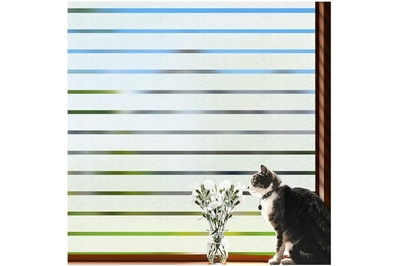Ask Wirecutter: Privacy Solutions for My Ground-Floor Windows

Inexpensive, a cinch to install, and no maintenance? Yes, please. Privacy film quickly adheres to glass and will last a long while.
Wirecutter style writer Zoe Vanderweide installed the striped version, pictured above, in a ground-floor bedroom. It allows the sun to shine in — without any peering eyes.
“It’s intended to go horizontally, but I think the vertical lines are much cuter, and it still allows for privacy,” she said.
I’ve used privacy film for the interior window on a door to my powder room, and it created instant solitude, no power tools needed. (Why is there an interior window on the door to a powder room, you ask? Just one of the quirks of living in a 100-plus-year-old house with original doors! And privacy film works!)
Before you order your privacy film in the pattern of your choosing, be sure to measure your glass, and check the size against the dimensions of the film you’re buying. You don’t want to end up short, since seams tend to look terrible between sheets of film.
My installation was, frankly, pretty slapdash, so to find some best practices, I checked with Carlos “The Texas Squeegee” Olazaba, who has been tinting windows professionally for 22 years and is the director of the window-tinting competition Tinter Battles.
- Clean the glass. This is crucial for the film to adhere well.
- Use a plastic scraper to remove any remaining dust, particles, or dirt from the glass. You don’t want to use anything metal that can scratch or cause abrasion.
- Mix water and a bit of dish soap in a spray bottle. Spritz the glass so it’s just barely damp. The dish soap allows the film to better slide into position.
- If the film is significantly larger than the glass, trim it so there’s only about an inch of overhang around the window. This will make it easier to install.
- Remove the clear backing from the film.
- Gently and carefully apply the film to the glass, starting with the top edge. This reduces overhang and prevents dirt from getting in between the film and the glass as you finish the install.
- Spray a light layer of water over the film, and use a rubber-edged squeegee to flatten the film from the top down, to clear any air bubbles. (The water allows the squeegee to slide smoothly over the film.) You can use a credit card or something similar with a hard plastic edge, but a squeegee will glide better and prevent rips.
- Trim the final edges with a sharp razor blade. You can do it freehand, but holding a plastic card or bowl scraper in place as you trim will help you get the smoothest, most consistent edge.
You might be tempted to skip the film and use a spray-paint frosting, like this one made by Rust-Oleum. But we’d caution against it (unless, of course, you’re a graffiti artist). Don’t discount the amount of prep and control required to spray the paint effectively, especially in a static indoor space.







